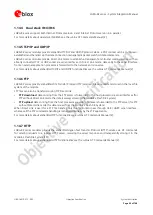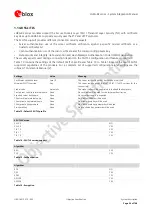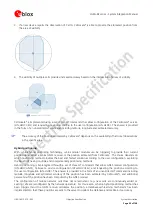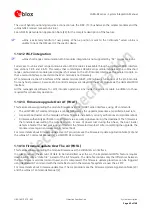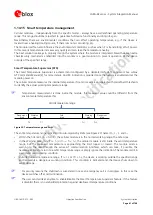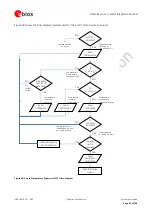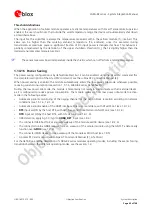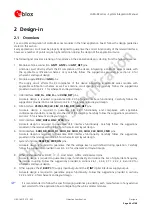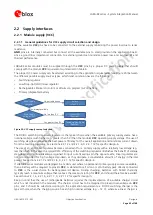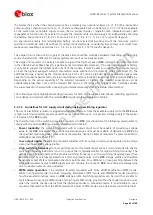
LARA-R2 series - System Integration Manual
UBX-16010573 - R02
Objective Specification
System description
Page 51 of 148
The RTC synchronization signal to the GNSS receiver: “GNSS RTC sharing” function provided by
GPIO4
improves GNSS receiver performance, decreasing the Time To First Fix (TTFF), and thus allowing to calculate
the position in a shorter time with higher accuracy. When GPS local aiding is enabled, the cellular module
automatically uploads data such as position, time, ephemeris, almanac, health and ionospheric parameter
from the positioning receiver into its local memory, and restores this to the GNSS receiver at the next power
up of the positioning receiver
For more details regarding the handling of the DDC (I
2
C) interface, the GNSS aiding features and the
GNSS related functions over GPIOs, see section 1.12, to the
[2] (AT+UGPS,
AT+UGPRF, AT+UGPIOC AT commands) and the
GNSS Implementation Application Note
“GNSS Tx data ready” and “GNSS RTC sharing” functions are not supported by all u-blox GNSS receivers
HW or ROM/FW versions. See the
GNSS Implementation Application Note
[22] or to the
Hardware
Integration Manual
of the u-blox GNSS receivers for the supported features.
As additional improvement for the GNSS receiver performance, the
V_BCKP
supply output of the cellular
modules can be connected to the
V_BCKP
supply input pin of u-blox positioning chips and modules to provide
the supply for the GNSS real time clock and backup RAM when the
VCC
supply of the cellular module is within
its operating range and the
VCC
supply of the GNSS receiver is disabled.
This enables the u-blox positioning receiver to recover from a power breakdown with either a hot start or a
warm start (depending on the duration of the GNSS receiver
VCC
outage) and to maintain the configuration
settings saved in the backup RAM.
1.9.5
SDIO interface
Secure Digital Input Output interface is not supported by LARA-R2 series modules “02” product versions.
LARA-R2 series modules include a 4-bit Secure Digital Input Output interface (
SDIO_D0
,
SDIO_D1
,
SDIO_D2
,
SDIO_D3
,
SDIO_CLK
,
SDIO_CMD
) designed to communicate with an external u-blox short range Wi-Fi module:
the cellular module acts as an SDIO host controller which can communicate over the SDIO bus with a compatible
u-blox short range radio communication Wi-Fi module acting as SDIO device.
The SDIO interface is the only one interface of LARA-R2 series modules dedicated for communication between
the u-blox cellular module and the u-blox short range Wi-Fi module.
The AT commands interface is not available on the SDIO interface of LARA-R2 series modules.
Combining a u-blox cellular module with a u-blox short range communication module gives designers full access
to the Wi-Fi module directly via the cellular module, so that a second interface connected to the Wi-Fi module is
not necessary. AT commands via the AT interfaces of the cellular module allows a full control of the Wi-Fi
module from any host processor, because Wi-Fi control messages are relayed to the Wi-Fi module via the
dedicated SDIO interface.
u-blox has implemented special features in the cellular modules to ease the design effort for the integration of a
u-blox cellular module with a u-blox short range Wi-Fi module to provide Router functionality.
Additional custom function over GPIO pins is designed to improve the integration with u-blox Wi-Fi modules:
Wi-Fi enable
Switch-on / switch-off the Wi-Fi
Wi-Fi enable function over GPIO is not supported by LARA-R2 series modules “02” product versions.



















